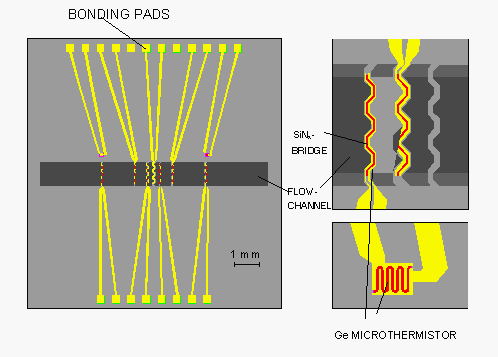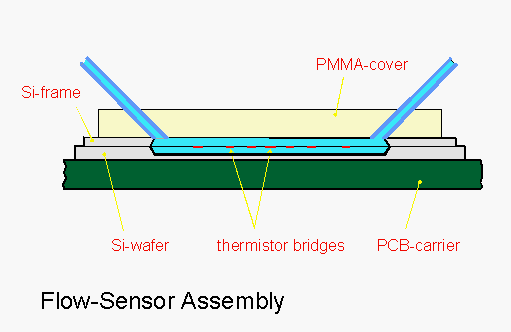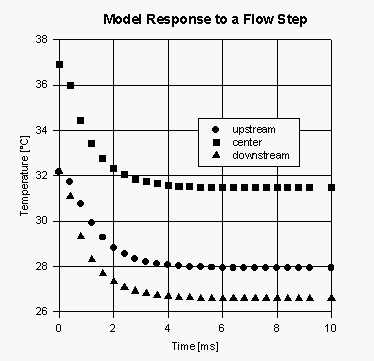
Fig. 1: Layout of a micromachined thermistor sensor array
The aim of the project was the realization of a microflow system with implemented thermosensors. High sensitive thin-film temperature sensor arrays based on a-Ge were already realized and exhibited high sensitivity combined with high spatial and time resolution. Entering the field of microsystem technology and silicon micromachining, a new generation of flow sensors could be realized based on the principle of heat anemometry. Simulations of thermal heat flow yield an optimized structure able to measure gas and liquid flow with high dynamic range and high time resolution. Devices for measuring the liquid in an implantable microvalve and gas in an air intake of a combustion engine were accomplished.
The aim of the project was the realization of a microflow system with implemented thermosensors. High sensitive thin-film temperature sensor arrays based on amorphous Germanium (a-Ge) were already realized and exhibited a high temperature resolution of 0.1 mK combined with a high spatial and a high time resolution of milliseconds [1]. For flow measurements, the principle of hot wire anemometry was modified. An a-Ge element acts as a heater and as a thermistor simultaneously. The cooling of the element, which is inserted in a flow stream, is the measured value and reflects the flow in an indirect way. This effect can also be used for measuring the blood flow in tissue and is called the method of heat clearance [2].
By using arrays of thermistor elements, a heating element passes heat into the flow, and the downstream thermistor will be additionally heated compared to an upstream sensor. In such a way the flow direction can be easily detected.
To enhance the sensitivity of a flow sensor, a thermal insulation from the substrate is favorable. An easy way to accomplish this task is the use of silicon micromachining by wet anisotropic etching. The use of silicon micromachined parts as essential elements of the construction of thermal flow meters results in reduced size, shorter response time and often less power consumption compared with classic flow rate meters [3, 4]. The use of a-Ge thermistors in combination with silicon micromachining increases the sensitivity and can further reduce the necessary thermal power and the disturbance of fluid temperature.
A flow channel can be formed in a silicon substrate, and a thermistor is placed on a silicon nitride bridge. An array of bridges crossing the silicon micromachined flow channel forms the base of the flow sensor. Each thermistor device consists of a vacuum-evaporated a-Ge resistor passivated by PECVD SiNx [5]. The SiNx acts as a mechanical support, as chemical insulation, and as a mask for the silicon etching.
A prototype device consisted of six thermistors and one thermistor/heating element [6]. Figure 1 shows the layout of the device.

Fig. 1: Layout of a micromachined thermistor sensor array
Such a device was mounted on a conventionally formed upper part made from PMMA to form a flow channel. The cross section is shown in Fig. 2.

Fig. 2: Cross section of the thermistor array integrated on a micromachined silicon substrate.
Such a device is able to measure the flow of liquids from 1 ml/h to 4 l/h, and of gases from 10 sccm to 3000 sccm. However, an optimization of the flow sensor device is highly recommended for special applications.
Two typical examples are given showing different applications measuring gases and liquids. These two tasks exhibit inherent problems, and therefore two different structures and measuring systems had to be developed. First, a flow sensor for combustion engines is presented, and second, a device for measuring liquids in an implantable microvalve.
The air intake rate of a combustion engine is one of the key parameters needed for the combustion process optimization. Knowledge of this parameter is essential if one tries to minimize both the engine's fuel consumption and the pollution of the environment. This rate should be known for each intake stroke. For the development of such engines, high resolution monitoring of the time function of air velocity during the stroke is also desirable. The suction strokes of the engine cause a discontinuous flow of air in the induction pipe. Depending on the number of revolutions per minute and the geometry of the suction pipe, the air flow can change from simple pulsations to an oscillating flow with large amplitudes. To investigate the dynamic behavior of a suction system, a useful flow sensor must offer quick response, high sensitivity, recognition of flow direction, and a wide dynamic range. Miniaturized thermal anemometers, based on thin film Ge thermistors, show a good compromise of the mentioned characteristics. The sensitivity of the thermistor could be greatly enhanced by mounting it on a micromachined thin membrane. Due to miniaturization, a faster response to flow changes can be achieved. Flow direction could be detected using two temperature sensors placed symmetrically to a thin film platinum resistor that represents the hot wire. A crosssection of the proposed sensor structure is depicted in Fig. 3. An array of those miniaturized flow sensors can be used to average spatial variation of the flow velocity field according to turbulent flow.

Fig. 3: Schematic cross section of the modeled flow sensor.
FE calculations were done using the ANSYS software package in order to simulate the thermal behavior and the flow dependence of the temperature field. Figure 4 depicts the temperature changes following a stepwise change of the flow velocity field. The time response and the sensitivity of the modeled structure both meet the requirements of the application. Our calculations have shown that the sensor response is determined essentially by the boundary layer of the flow. The supplied heat does not penetrate very deeply into the flowing medium, since the relevant dimensions of the sensor are smaller than or comparable to the boundary layer thickness. Fluctuations, which are typical for a turbulent flow, will be averaged very efficiently by this arrangement.

Fig. 4: Calculated time dependence of temperature following a step change of flow velocity.
This project is a contribution to the development of a miniaturized all silicon device for the aid of patients suffering from hydrocephalus. This device should measure the intracranial pressure and automatically open a shunt for excessive liquor cerebrospinalis if required. A micro machined valve and a miniaturized flow sensor are the key parts of this device. The valve, developed by IMT Dresden, opens if the differential pressure rises above the allowed limit. The flow sensor serves for continuous monitoring as well as control functions.
The flow sensor should not hinder the free flow of liquor. Therefore we developed a micro machined Si structure which on the one hand ensures good thermal parameters for the detection of flow and on the other hand provides the desired flow channel dimensions. The outline of the flow sensor was designed to fit perfectly into the micro flow channel concept of the device. Only a very low value for the overtemperature of the flowing medium is acceptable for this application. Ge thin film thermistors offer the possibility to build very sensitive flow sensors based on the hotwire anemometer principle. They need only slightly elevated temperatures to generate a reliable readout. We used a two-dimensional model of the sensor geometry for FE calculations of the temperature fields to simulate the flow response.
Operation safety considerations led to a design consisting of two flow sensing sites (Fig. 5). Further requirements are the recognition of the flow direction and the compensation of changes in the ambient temperature. Thus a total of six thermistors and two thin film platinum resistors for the heat generation were integrated on the sensor chip. The sensor was realized using the mask alignment equipment of the MISZ that is capable for mask adjustment related to structures on the backside of the wafer.

Fig. 5: A thermal flow sensor placed on a SiNx microbridge. Flow channel width measures 1 mm. A thin film platinum resistor of 750 ohms is located in the mid of two thin film Ge thermistors with a resistance of 56 kohms.
The flow sensor is integrated in a micromachined microvalve which can be implanted into the scull.
First samples of the sensor chip are currently under investigation at IMT Dresden and in our laboratories at the TU Vienna. It is planned to implement similar sensors in automated drug delivery devices.
The presented flow sensor arrangements are characterized by using thin film amorphous Germanium thermistor arrays and metal heating elements that are mounted in the center plane of a micromachined flow channel. Due to the insulation of the thermistors with SiNx, the flow sensor can be used for flow sensing of gases as well as liquids. The flow dependence of the thermal conductivity was investigated by FE analysis, which is an important fact to optimize the structure due to the different applications and measuring principles.
It seems possible to design a flow sensor for a wide range of applications to match the desired dynamic range and time resolution in gases as well as in liquids.
The combination of high sensitive planar thin-film thermistors with micromachining opens the possibility to produce flow sensor devices for medical applications, process engineering and chemical engineering.
The future aim is the development of a complete analytical laboratory on chip with different integrated sensors to perform physical-chemical analysis simultaneously and directly on the measuring site.
This work was supported in part by the Austrian Science foundation (FWF) grant 9717, the Ludwig Boltzmann Gesellschaft, the Ministry of Science and Arts, the company IMT, Dresden and the company AVL.
[1] G. Urban, A. Jachimowicz, F. Kohl, H. Kuttner, F. Olcaytug, P. Goiser, O. Prohaska: "High resolution thin-film temperature sensor arrays for medical applications", Sensors & Actuators A, 22 (1990), 650 - 654.
[2] H. Kuttner, G. Urban, A. Jachimowicz, F. Kohl, F. Olcaytug, P. Goiser: "Microminiaturized Thermistor Arrays for Temperature Gradient, Flow and Perfusion Measurements", Sensors and Actuators A, 25 - 27 (1991), 641 - 645.
[3] R.G. Johnson, R.E. Higashi: "A highly sensitive silicon chip microtransducer for air flow and differential pressure sensing applications", Sensors and Actuators, 11 (1987), 63 - 72.
[4] C. Yang, H. Soeberg: "Monolithic flow sensor for measuring millilitre per minute liquid flow", Sensors and Actuators A, 33 (1992), 143 - 153.
[5] F. Olcaytug, K. Riedling, W. Fallmann: "A low temperature process for the reactive formation of Si3N4 layers on InSb", Thin Solid Films, 67 (1980), 321 - 324.
[6] F. Kohl, A. Jachimowicz, J. Steurer, R. Glatz, J. Kuttner, D. Biacovsky, F. Olcaytug, G. Urban: "A micromachined flow sensor for liquid and gaseous fluids", Sensors and Actuators A, 41, 1 - 3, (1994), 293 - 299.
Univ.-Doz. Dr. Gerald URBAN
Institut für Allgemeine Elektrotechnik und Elektronik, TU Vienna
Last Name First Name Status Remarks
Urban Gerald associate
professor
Kohl Franz assistant
professor
Jachimowicz Artur assistant 50% GMe funding
professor
Biacovsky Dalibor dissertation
Steurer Johannes assistant partially GMe funded
professor
Glatz Ronald technician